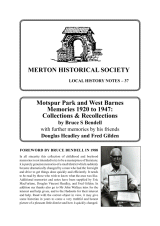Local History Notes
This series of leaflets and booklets are printed in-house. They provide an opportunity to publish memories by local residents, and other source material, at low cost. We are currently making the older and slimmer reminiscences available as free downloads, though printed copies can still be purchased.
We would particularly welcome reminiscences of local commercial and industrial activities.
We would also welcome more transcripts of local source material, and also offers from people willing to check draft transcripts.
Mitcham in 1846: The Tithe Apportionment Map
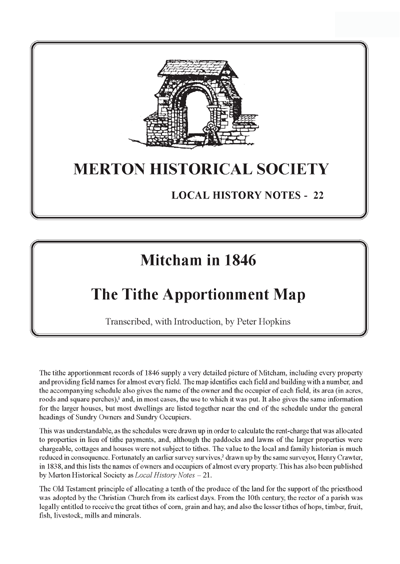
The tithe apportionment records of 1846 supply a very detailed picture of Mitcham, including every property and providing field names for almost every field. The map identifies each field and building with a number, and the accompanying schedule also gives the name of the owner and the occupier of each field, its area (in acres, roods and square perches), and, in most cases, the use to which it was put. It also gives the same information for the larger houses, but most dwellings are listed together near the end of the schedule under the general headings of Sundry Owners and Sundry Occupiers.
Morden in 1838: The Tithe Apportionment Map

The tithe apportionment for Morden, which is the earliest for the four ancient parishes which make up the present London Borough of Merton, dates from 1838. It is also one of the most detailed, covering every property in Morden, and providing field names for almost every field. The map identifies each field and building with a number, and the accompanying schedule also gives the name of the owner and the occupier, its area (in acres, roods and perches), and, in most cases, the use to which it was put.
Morden in 1910: The Land Valuation Records (‘Lloyd George’s Domesday’)

A unique view of Morden just before it was overwhelmed by suburbia. Every property, including building plots, is listed, with details of owner, occupier, leases and rents. Many properties have full descriptions, some with plans. The original maps are missing but Rosemary Turner has reconstructed them and plotted each property onto the 1912 OS map.
More Memories of Manor Road in the 1920s Mitcham
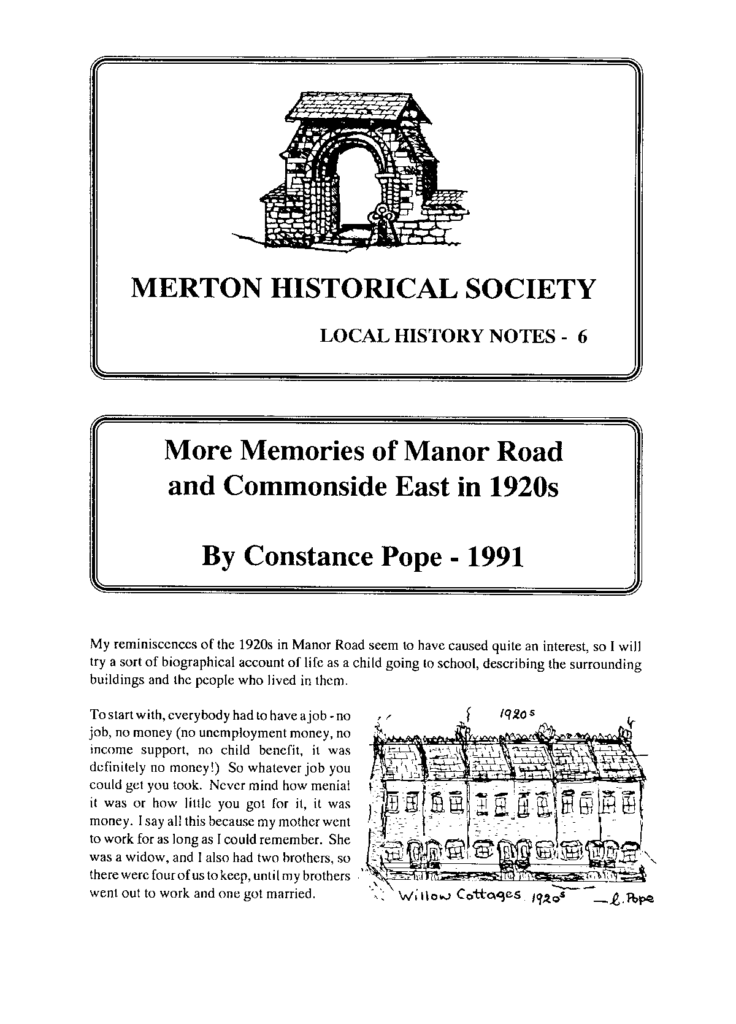
Constance Pope’s reminiscences of the 1920s in Manor Road, published as Local History Notes 2, aroused considerable interest. In this, her second set of recollections, she gives “a sort of biographical account of life as a child going to school, describing the surrounding buildings and the people who lived in them.” Her account is complemented by delightful pen-and-ink sketches of the properties mentioned in the text.
Once Upon a Time: Recollections of an Edwardian Childhood in Colliers Wood
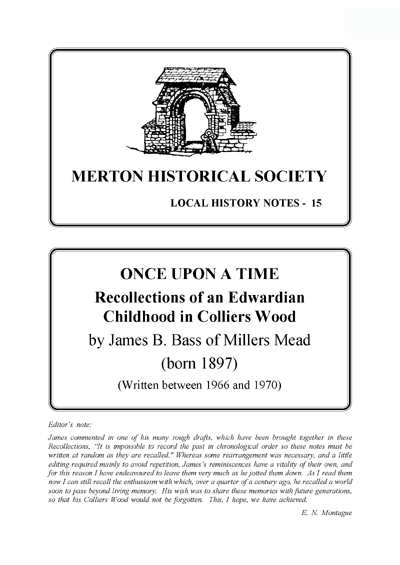
These engaging reminiscences, put on paper between 1966 and 1970, have been edited by Eric Montague. Mr Bass, who was born in 1897, recalled with affection the ‘compact community’ of early 20th-century Colliers Wood, the games, treats and semi-rural pleasures of childhood in the days of horse-buses; the annual highlights of Epsom Week and Sanger’s Circus; and the coming of the electric tram and the cinema.
Parishioners of Mitcham 1837/38:
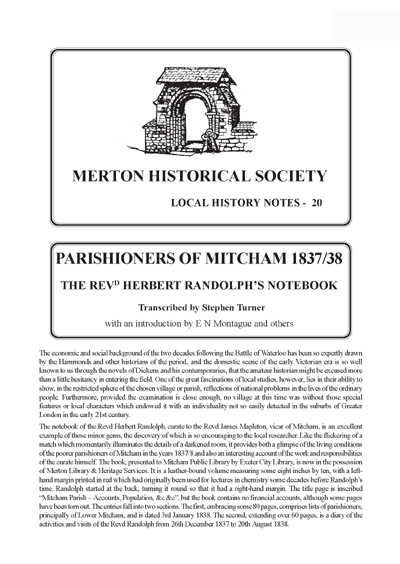
The notebook of the Revd Herbert Randolph, curate to the Revd James Mapleton, vicar of Mitcham, is an excellent example of those minor gems, the discovery of which is so encouraging to the local researcher. Like the flickering of a match which momentarily illuminates the details of a darkened room, it provides both a glimpse of the living conditions of the poorer parishioners of Mitcham in the years 1837/8 and also an interesting account of the work and responsibilities of the curate himself.
The entries fall into two sections. The first comprises lists of parishioners, principally of Lower Mitcham, and is dated 3rd January 1838. The second is a diary of the activities and visits of the Revd Randolph from 26th December 1837 to 20th August 1838.
Ravensbury: a poem written after a visit in 1850, recollecting childhood memories of people, places and events
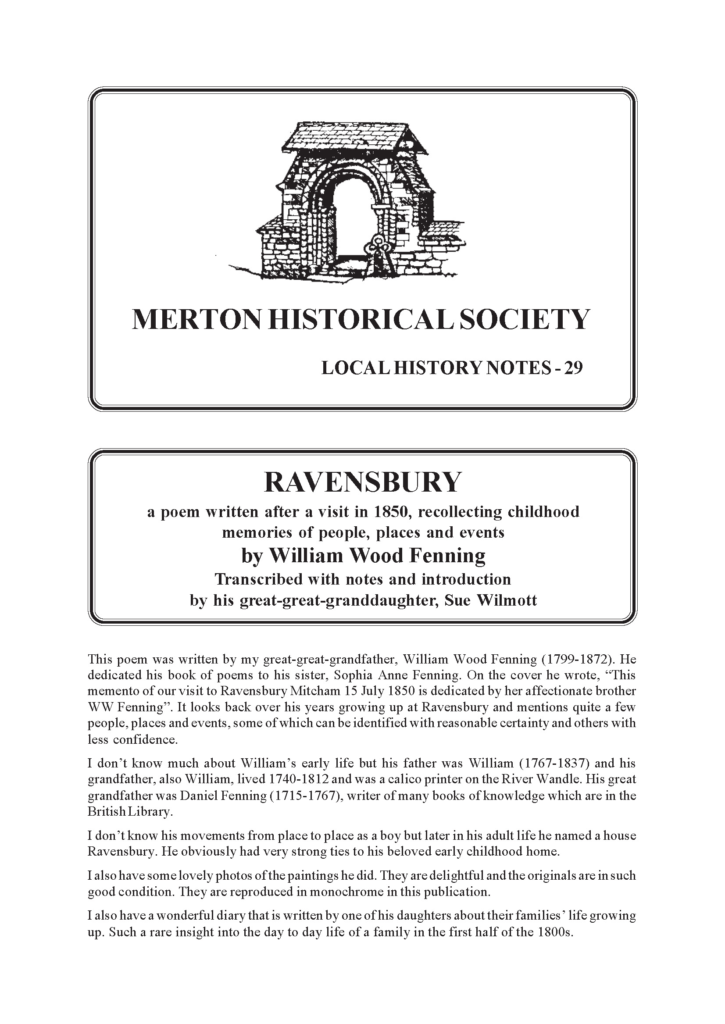
Sue Wilmott’s great-great-great-greatgrandfather, William Fenning, and his son, also William, were proprietors of the Ravensbury Printworks at the end of the 18th and in the early 19th centuries. Sue’s great-great-grandfather, William Wood Fenning, revisited Ravensbury in July 1850, probably for the funeral of his sister, and wrote a long poem looking back over his years growing up at Ravensbury and mentioning quite a few people, places and events. Sue has transcribed the poem, and added explanatory notes. Illustrated with monochrome copies of William Wood Fenning’s watercolours of the area, this booklet adds considerably to our understanding of our locality at this time.
Reminiscences of Park Place
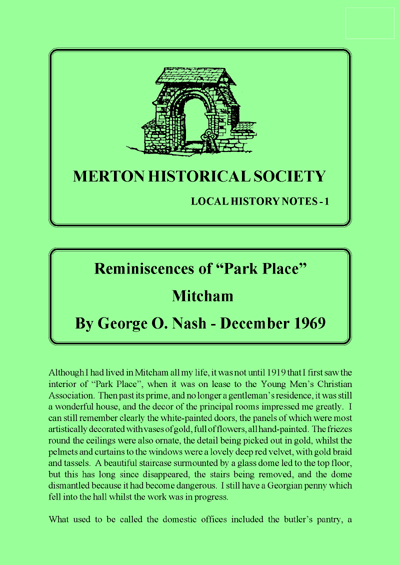
Park Place, now a restaurant, is an 18th-century house, once used by the News of the World as the clubhouse for their sports ground.
George Nash became a groundsman there in the 1920s and remained for over 40 years. His recollections of the house and grounds date back to 1919.
The changes that had taken place in the 60-odd years that George Nash had known the house and its grounds were very great. The conversion of Park Place from a gentleman’s residence to a clubhouse and sports ground in the 1920s had necessitated quite drastic alterations, but many of the old outbuildings, like the stables and the coach house, survived until, damaged by a flying bomb, they were demolished after the war. The mid-Georgian wing of the house, once the domestic quarters, also sustained damage during the Blitz, but was repaired.
Some Memories of Tower Creameries, Mitcham
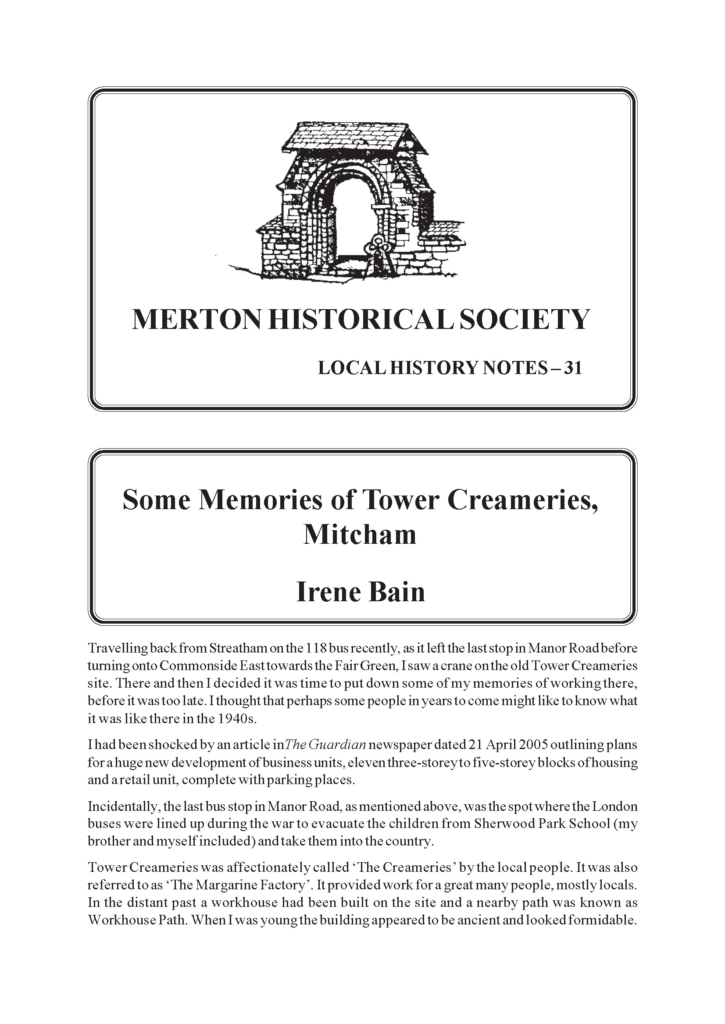
Stirred by the sight of a massive redevelopment on the site of the Tower Creameries, Irene Bain has recorded her memories of working there in the 1940s. After a short spell with C&A Modes in Oxford Street, she began at the Creameries as a messenger girl in 1944. Her duties took her into almost every department and office, and her memoir takes us by the hand and gives us a guided tour of the entire premises. This is far from a mere list of rooms, as it is illuminated by deft sketches of the people who worked in them. This includes all three directors, who were obviously kind men. Irene moved on to the Accounts Department and then the Typists Room, and gives us a real feel for working in them, with some lively anecdotes. Her affection for the Creameries shows through: ‘It was a lovely place to work’, she says. And this is a lovely read.
Sporting Memories of Mitcham in the late 1940s and 1950s
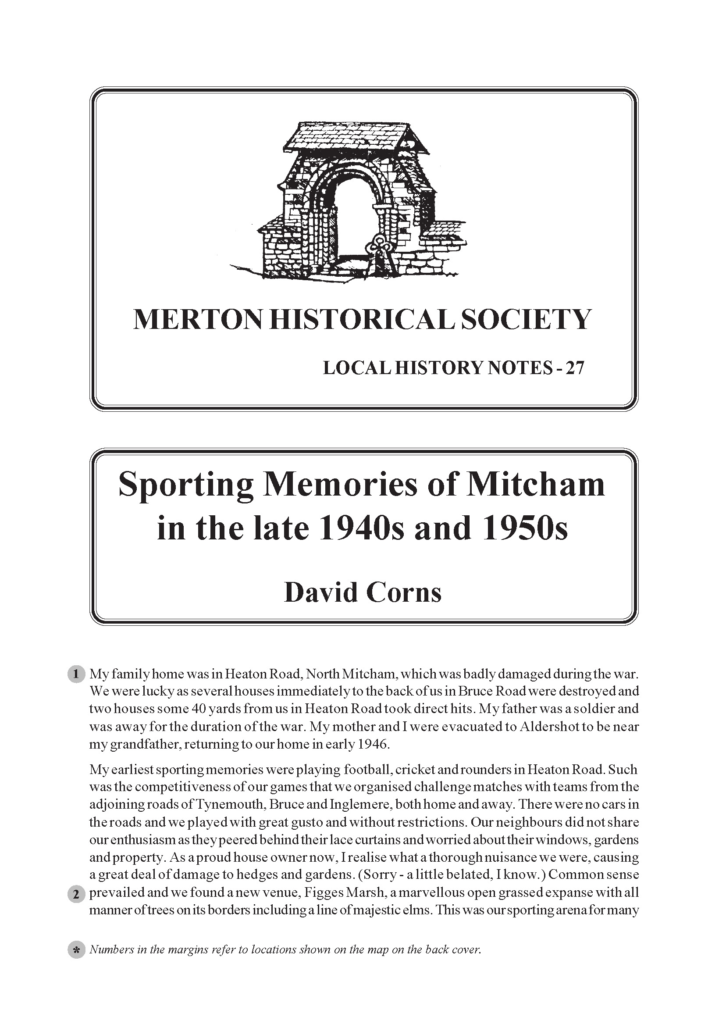
The author’s recollections of a sporting boyhood will strike a chord with many readers, though few will probably have managed to participate in and/or watch as much sport as David Corns. As a cub and then a scout, at primary and then grammar school, in informal ‘gangs’ and then in clubs, he played football, cricket, rounders and Korfball, as well as swimming, running and long-jumping. He watched fine cricketers on the Green and world-class athletes at the News of the World ground, and he writes about it all with enthusiasm and total recall.
Stane Street in Upper Morden

In the autumn of 1963, construction works were carried out by Post Office Telephones for a new service chamber in the public pavement of London Road near the entrance to Morden Park. The opportunity was taken by Bill Rudd, in the brief time available, to examine and photograph the excavation before construction commenced. Chalk and flint layers appear to be authentic remains of the Roman road now known as Stane Street.
The Landmark Case of British Railways Board v Herrington
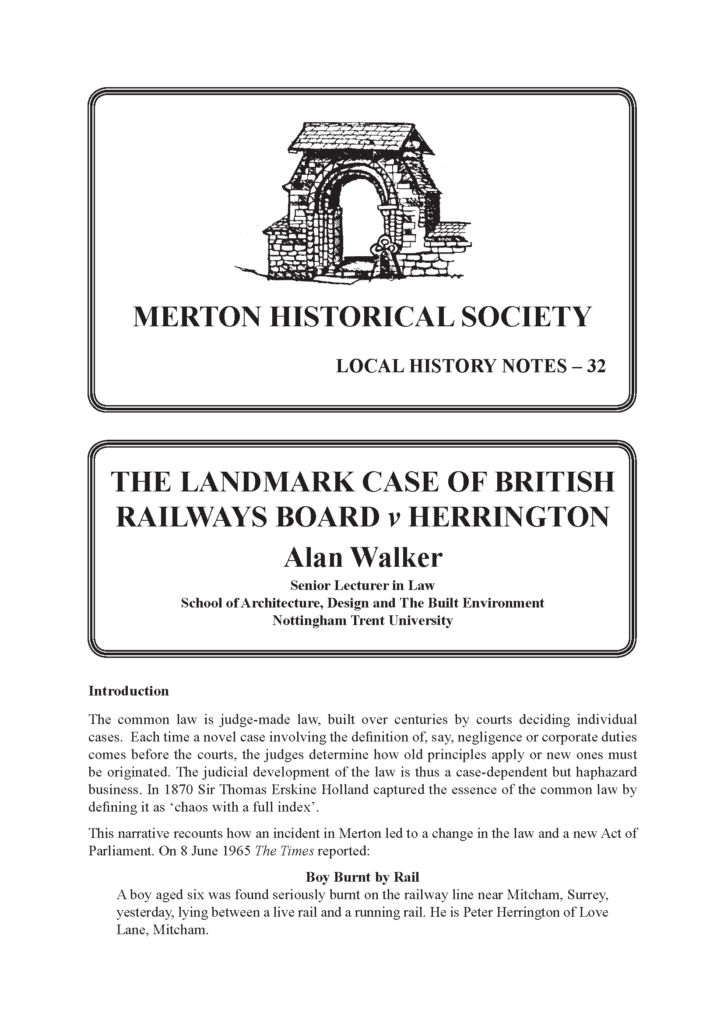
When six-year-old Peter Herrington, from Love Lane, Mitcham, was seriously burnt on the railway line between Mitcham and Morden Road stations in June 1965, he made legal history. In this study, Alan Walker, senior lecturer in law at Nottingham Trent University, explains the background to, and the implications of, this important case, which led to a change in the law and a new Act of Parliament.
The Life of James Lackington, Bookseller, 1746-1815
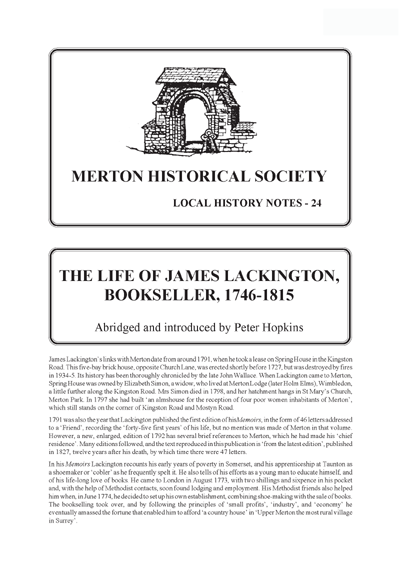
James Lackington, the 18th-century bookseller, developed trading policies that were to bring him both fame and financial success. His terms became (unusually for the time) cash only; he sold at rock-bottom prices, and he was a pioneer dealer in large quantities of publishers’ ‘remainders’, which he sold at cut price. He also bought up whole libraries, and was soon issuing catalogues of 30,000 volumes and more.
By 1791, when his annual profits were £4000, and he wrote the first version of his Memoirs, he had installed himself with his wife Dorcas in a country house in Merton and set up his own carriage. This was Spring House, the early 18th-century house in Kingston Road, which was demolished in the 1930s and replaced by the Spring House flats.
The Mitcham That I Remember 1927-1941

Iris C Marshall, née Overy grew up at the Ward paint factory in Windmill Road, Mitcham, and describes life in the area mainly during the 1930s.
The Parish of Merton in 1844: The Tithe Apportionment Map
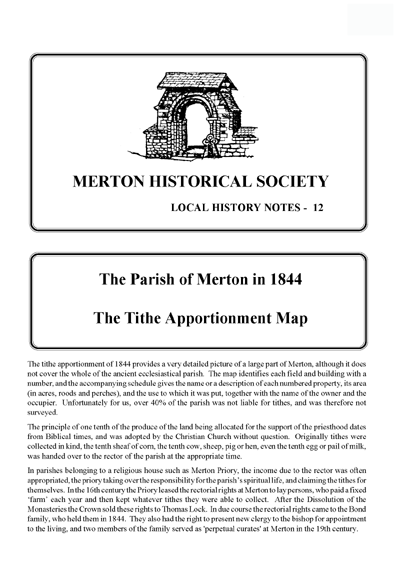
The tithe apportionment of 1844 provides a very detailed picture of a large part of Merton, although it does not cover the whole of the ancient ecclesiastical parish. The map identifies each field and building with a number, and the accompanying schedule gives the name or a description of each numbered property, its area (in acres, roods and perches), and the use to which it was put, together with the name of the owner and the occupier.
The Story of the Long Thornton and District Improvement Society

This Association was formed in 1927 by people who were buying houses on a new privately-built estate with only temporary road surfaces which had to be repaired by the residents at week-ends, poor street lighting, no buses or schools and few shops. By electing a politically independent councillor and constantly pushing the authorities hard, they achieved the local facilities and amenities they needed.
Christine Munday has produced a piece of social history and a very warming account of what ordinary people can achieve when banding together for a common good.
 MERTON HISTORICAL SOCIETY
MERTON HISTORICAL SOCIETY 